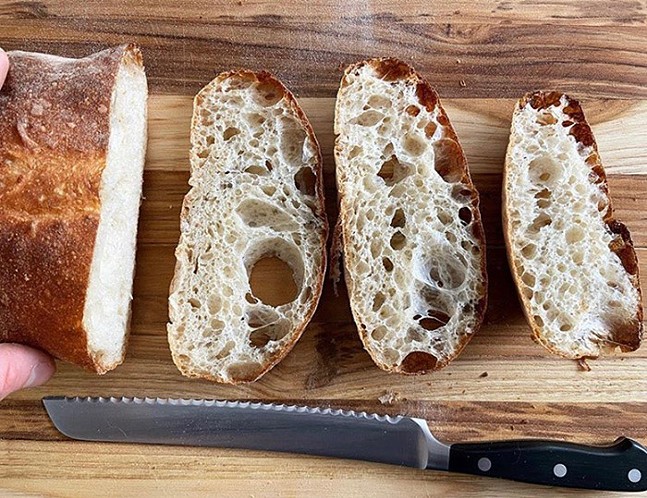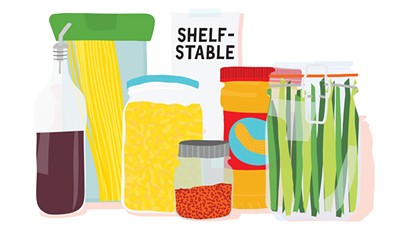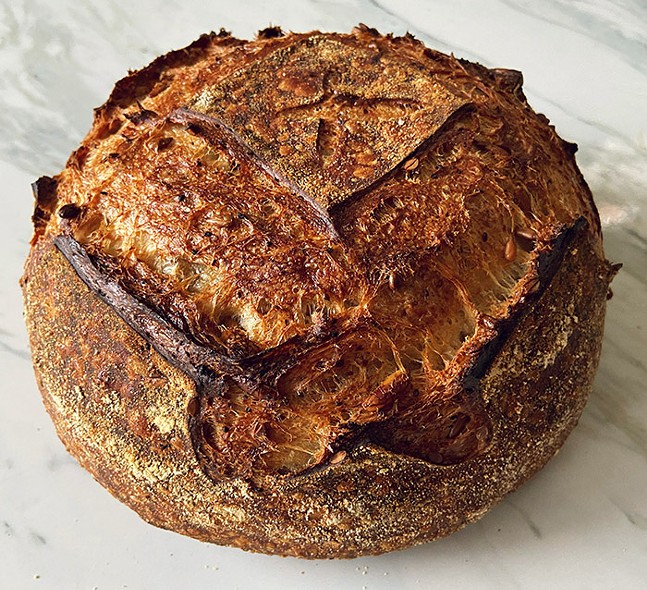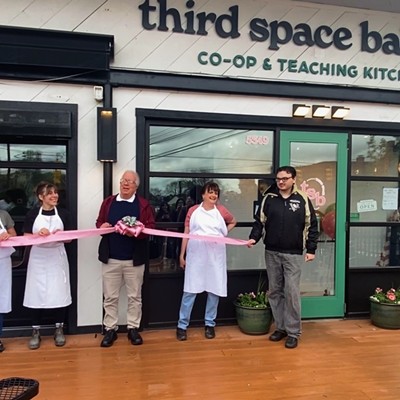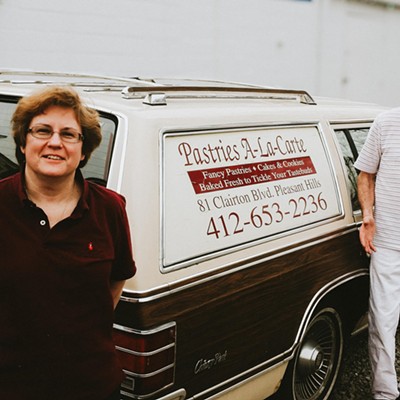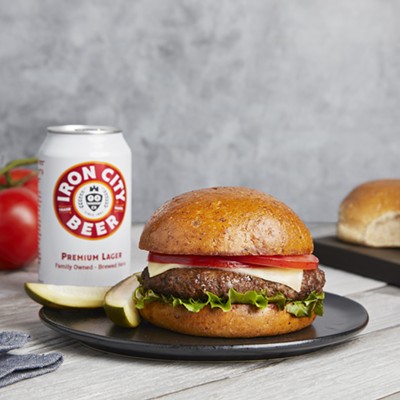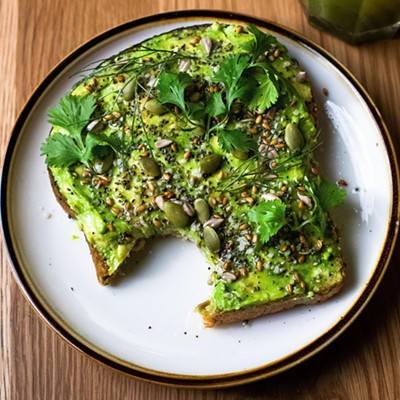BAKING BREAD
Bread is one of the oldest human-made foods. Nearly two years ago, a piece of 14,000 year old bread was found in Jordan, a discovery which meant that early humans first learned how to bake before they learned how to farm. In its simplest form, the ingredient list is short; bread is made from a dough of flour and water, and falls under two main categories — leavened (bread with yeast or an agent to make it rise) and unleavened (bread without yeast, like matzo or tortilla).
After scrolling through recipes online, I finally reached out to Nick Malburg, the bread manager at DiAnoia's Eatery. Malburg, who posts his personal and professional baking projects as Wild Science Bread on Instagram shared his thoughts on baking bread during this time. Allowing enough flexibility in your schedule to let the dough do what it fully needs to do instead of rushing through the process is his first tip.
“Often, the most overlooked part of a recipe is time. Be patient and listen to your dough when proofing it and baking it. If a recipe says, ‘Let rest 30 minutes to 1 hour, or until doubled in size,’ take the time to assess the dough before moving on. 'Thirty minutes to 1 hour' may not be right for your home environment. All sorts of factors like humidity and temperature can affect the yeast’s activity. Keep an eye on it, and let the yeast work its magic at its own pace,” Malburg explains. “Weighing and mixing ingredients is simple, but giving the dough the time it needs can be the difference between good and great bread.”
When choosing a recipe, Malburg suggests picking one written by weight. Weighing ingredients with a kitchen scale means the bake will be more accurate and consistent, so it’s a good sign that the recipe is thought out and tested, he explains.
Malburg said to look for bread flour in the grocery store, which has a higher protein content, which helps the gluten develop and the bread rise in the oven. You can also take things a step further if you want to experiment with flavor and use whole wheat flour, or a speciality grain like spelt flour. “If you want to get very specific with your flour purchases, look for stone ground flours and avoid roller milled flours. The heat in the roller milling process can kill many of the good enzymes that work with the yeast and natural bacterias in breads and end up producing a below spectacular bread. Stone milled flour may be more expensive, but will have better functionality in yeasted and naturally leavened breads.”
As for the sourdough project I have been considering for years? I got in touch with Omar Abuhejleh, owner of Allegro Hearth Bakery and B52, who is using this time to develop some of his own breads. “I often field inquiries about our sourdough starter,” he said. “I think a lot of people are enticed by the allure of a very old sourdough starter with a great origin story. But my experience is that you can bake great bread with a sourdough starter you create yourself in about a week and the process is amazingly simple.” You can find an outline of Abuhejleh’s process below.
Malburg also encourages researching and exploring the process of creating a sourdough starter during this time. “It is an endlessly fun world in which to get lost, but it can be quite involved. Consider reaching out to someone you may know or a local bakery to ask for a starter and a few pointers!”
If you’re still feeling apprehensive about baking bread that Paul Hollywood would approve of, don’t worry. There are plenty of baking projects that come with less high stakes like a flatbread or naan, which take far less time to prepare but are delicious and rewarding to eat. I’ve also had several friends recommend Bon Appetit’s focaccia which looks very fun to shape by poking a bunch before baking. Banana bread, which mixes up as a batter and uses basic pantry ingredients, is a great option if you’re looking for something sweet.
Malburg’s parting words of wisdom gave me encouragement: “Don't worry about it! When baking bread, the ingredients are fairly cheap and minimal. It can be easy to feel intimidated by the wide world of breads and bakers we see on Instagram, and the stakes can feel very high to produce a good, beautiful loaf of bread. The truth is, the worst thing that can happen is a bread that you're not happy with. Take your time, have fun, and I'll bet just about anything that it'll taste just fine!”
• Resources from King Arthur Flour
• Resources from Epicurious
• Naan Bread
• Easy No Knead Focaccia by Bon Appetit
• Ultimate Banana Bread from Smitten Kitchen
Guidelines for Homemade Sourdough Starter
from Omar Abuhejleh
Mix flour and water and let it sit at room temperature (anywhere from 65-75 degrees) in any covered container. Once a day, discard a majority of the mix and feed it more flour and water. (A super simple ratio is 1:2:2. One part old starter, two parts water, and two parts flour.) For my flour, I use a 1:1 ratio of bread flour and whole wheat flour.
The first few days, there is little if any discernible difference, but by the fourth day, you'll start to notice bubbles and a bit of vinegary or acidic smell. After a few more days of regular feedings, your starter is ready to go.
After that, depending on use, you can feed it once a day, a couple of times a day, or put in the refrigerator and feed it a couple of times a week. Once established, the starter is pretty resilient.
You can use a very small amount of it in your dough recipe in place of yeast for a bread with little to no sour flavor, or you can use more and extend the fermentation time (by mixing dough with cold water or refrigerating dough) if you're looking to bake a more traditional sourdough bread.

